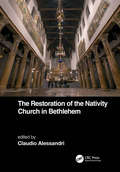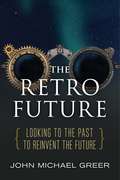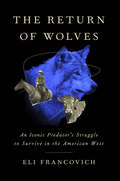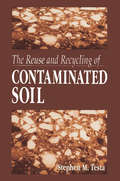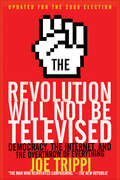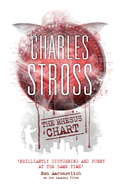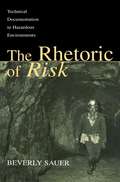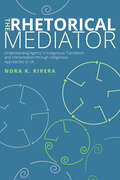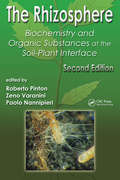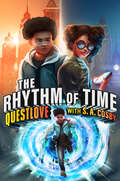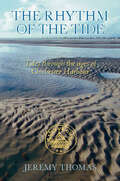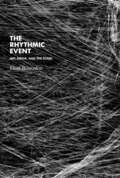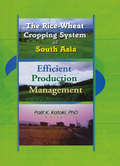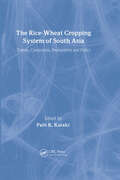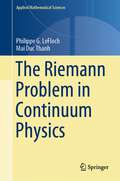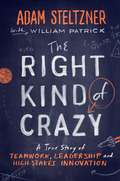- Table View
- List View
The Restoration of the Nativity Church in Bethlehem
by Claudio AlessandriThis book is a summary of the main restoration works carried out at the Church of the Nativity in Bethlehem that commenced in September 2013. Work on roof wooden structures, wall and floor mosaics, internal plasters, wooden architraves and painted columns of the naves, external wall surfaces and Narthex is all presented in a sequence of reports that accompany the reader up to the final interventions through accurate descriptions of historical and archaeological features, initial state of conservation and appropriate techniques of conservation and restoration. Topics are treated with the methodological and linguistic rigor specific to each disciplinary sector involved even if, in the interest of making reading and comprehension easier, it was sometimes preferred to present only significant case studies, which are nevertheless representative of groups of wider and more complex problems. Through the reading of this work, the reader can simply fulfil his desire for knowledge and obtain answers to certain curiosities about the past history of the Church. At the same time, useful guidelines in dealing with conservation and restoration interventions at historic-architectural sites of similar complexity can be found. The book is, therefore, addressed to a generic reader, interested in the history and conservation of one of the most representative examples of our heritage, but also, in light of its technical and scientific value, to university students, technicians, restorers, architects, structural engineers, archaeologists and historians.
The Restoring Ecological Health to Your Land Workbook (Science Practice Ecological Restoration)
by Steven I. Apfelbaum Alan HaneyThis is the first practical guidebook to give restorationists and would-be restorationists with little or no scientific training or background the "how to" information and knowledge they need to plan and implement ecological restoration activities. The first part of the book introduces the process of ecological restoration in simple, easily understood language through specific examples drawn from the authors' experience in restoring their own lands. The second half shows how that same "thinking" and "doing" can be applied to North America's major ecosystems and landscapes in any condition or scale. No other ecological restoration book leads by example and first-hand experience like this one. It represents a unique and important contribution to the literature on restoration.
The Resurrection Key (Wilde/Chase #15)
by Andy McDermottAN EXPLOSIVE NEW WILDE AND CHASE ADVENTURE FROM THE INTERNATIONAL BESTSELLING AUTHOR. 'Action, adventure and mayhem aplenty' Scott Mariani'A writer of almost cinematic talent' - Daily ExpressTheir days of death-defying adventure seemingly behind them, acclaimed archaeologist Nina Wilde and her husband, ex-SAS soldier Eddie Chase, live like any normal family. However, when a mythical civilisation is unearthed deep in the Antarctic ice, they are drawn into a battle for control of its astonishing power.Dashing from New York to New Zealand, from futuristic Chinese cities to the outback of Australia, they soon confront the gravest threat they've ever faced. Pursued by ruthless mercenaries and a secret special forces unit, Nina and Eddie discover the clock is counting down to the extermination of all humanity...Globe-trotting and breathless, this is perfect for fans of action thriller authors like Clive Cussler and Scott Mariani. Praise for Andy McDermott:'A writer of almost cinematic talent' - Daily Express, Scotland'Adventure stories don't get much more epic than this' - Mirror'McDermott raises the bar. . . non-stop high octane action' Publishers Weekly
The Resurrection Key (Wilde/Chase #15)
by Andy McDermottIn the most explosive book of the thrilling Wilde and Chase series, the intrepid pair must race against time before an ancient force is unleashed on the world... Their days of death-defying adventure seemingly behind them, acclaimed archaeologist Nina Wilde and her husband, ex-SAS soldier Eddie Chase, live like any normal family. However, when a mythical civilisation is unearthed deep in the Antarctic ice, they are drawn into a battle for control of its astonishing power.Dashing from New York to New Zealand, from futuristic Chinese cities to the outback of Australia, they soon confront the gravest threat they've ever faced. Pursued by ruthless mercenaries and a secret special forces unit, Nina and Eddie discover the clock is counting down to the extermination of all humanity...Praise for Andy McDermott:'A writer of almost cinematic talent' - Daily Express, Scotland'Adventure stories don't get much more epic than this' - Mirror'McDermott raises the bar. . . non-stop high octane action' Publishers Weekly
The Resurrection Key (Wilde/chase Ser. #15)
by Andy McDermottIn the most explosive book of the thrilling Wilde and Chase series, the intrepid pair must race against time before an ancient force is unleashed on the world... Their days of death-defying adventure seemingly behind them, acclaimed archaeologist Nina Wilde and her husband, ex-SAS soldier Eddie Chase, live like any normal family. However, when a mythical civilisation is unearthed deep in the Antarctic ice, they are drawn into a battle for control of its astonishing power.Dashing from New York to New Zealand, from futuristic Chinese cities to the outback of Australia, they soon confront the gravest threat they've ever faced. Pursued by ruthless mercenaries and a secret special forces unit, Nina and Eddie discover the clock is counting down to the extermination of all humanity...Praise for Andy McDermott:'A writer of almost cinematic talent' - Daily Express, Scotland'Adventure stories don't get much more epic than this' - Mirror'McDermott raises the bar. . . non-stop high octane action' Publishers Weekly
The Retro Future: Looking to the Past to Reinvent the Future
by John Michael GreerThe author of The Long Descent examines a solution for the troubles of our modern age: technical regression.To most people paying attention to the collision between industrial society and the hard limits of a finite planet, it’s clear that things are going very, very wrong. We no longer have unlimited time and resources to deal with the crises that define our future, and the options are limited to the tools we have on hand right now.This book is about one very powerful option: deliberate technological regression.Technological regression isn’t about “going back”—it’s about using the past as a resource to meet the needs of the present. It starts from the recognition that older technologies generally use fewer resources and cost less than modern equivalents, and it embraces the heresy of technological choice—our ability to choose or refuse the technologies pushed by corporate interests.People are already ditching smartphones and going back to “dumb phones” and land lines and e-book sales are declining while printed books rebound. Clear signs among many that blind faith in progress is faltering and opening up the possibility that the best way forward may well involve going back.A must-read for anyone willing to think the unthinkable and embrace the possibilities of a retro future.Praise for The Retro Future“Whether or not you accept John Michael Greer’s argument that a deindustrialized future is inevitable, you’ll appreciate his call for the freedom to select the best technologies of the past—worthy and sustainable tools, not pernicious prosthetics. Greer’s vision of a “post-progress” world is clear, smart, and ultimately hopeful.” —Richard Polt, professor of philosophy, Xavier University; author, The Typewriter Revolution: A Typist’s Companion for the 21st Century“What might your life be like without an automobile, TV, or a mobile phone? Ask John Michael Greer, who lives that way and recommends it as practice for the soon-to-be-normal. Greer says we are embarked upon the post-progress era. Climate change, loose nukes, and resource exhaustion are among its many challenges. In The Retro Future, Greer looks backward to mark the way forward.” —Albert Bates, author, The Post-Petroleum Survival Guide, The Biochar Solution, and The Paris Agreement
The Return of Wolves: An Iconic Predator's Struggle to Survive in the American West
by Eli FrancovichUncover on-the-ground reporting on the conflict between conservationists, ranchers, and an iconic predator—and discover the solution that might appease them all. The gray wolf has made an astonishing comeback in Washington. Nearly eradicated by the 1990s, conservationists and environmentalists have cheered its robust return to the state over the last two decades. But Washington ranchers are not so joyous. When wolves prey on livestock, ranchers view their livelihood as under attack. In The Return of Wolves, journalist Eli Francovich investigates how we might mend this divide while keeping wolf populations thriving. He finds an answer in the time-honored tradition of range riding and one passionate range rider, Daniel Curry, who has jumped directly into the fray by patrolling the rural Washington landscape on horseback. Curry engages directly with farmers, seeking to protect livestock from wolves while also protecting and proliferating wolf populations. In The Return of Wolves, we meet an eclectic cast of players—local ranchers, politicians, environmentalists, and everyday folks caught in the middle—and find hope for the future of wolves, and perhaps for our divided nation.
The Reuse and Recycling of Contaminated Soil
by Stephen M. TestaThis book presents a new way of viewing contaminated soil-as a resource that in many instances can be recovered. The Reuse and Recycling of Contaminated Soils addresses the waste problem associated with contaminated soil and considers alternatives that are environmentally sound, cost-effective, and time efficient. It provides thorough coverage of practical issues associated with reuse and recycling.
The Revenge of Analog: Real Things and Why They Matter
by David SaxOne of Michiko Kakutani's (New York Times) top ten books of 2016A funny thing happened on the way to the digital utopia. We've begun to fall back in love with the very analog goods and ideas the tech gurus insisted that we no longer needed. Businesses that once looked outdated, from film photography to brick-and-mortar retail, are now springing with new life. Notebooks, records, and stationery have become cool again. Behold the Revenge of Analog.David Sax has uncovered story after story of entrepreneurs, small business owners, and even big corporations who've found a market selling not apps or virtual solutions but real, tangible things. As e-books are supposedly remaking reading, independent bookstores have sprouted up across the country. As music allegedly migrates to the cloud, vinyl record sales have grown more than ten times over the past decade. Even the offices of tech giants like Google and Facebook increasingly rely on pen and paper to drive their brightest ideas.Sax's work reveals a deep truth about how humans shop, interact, and even think. Blending psychology and observant wit with first-rate reportage, Sax shows the limited appeal of the purely digital life-and the robust future of the real world outside it.
The Revolution Will Not Be Televised: Democracy, the Internet, and the Overthrow of Everything
by Joe TrippiIn a blend of Wired magazine and The Boys on the Bus, the man who invented Internet politics tells the story of how it was done and reveals how every sector can benefit from tech revolution.Campaign manager Joe Trippi, who signed on to run Howard Dean’s campaign when there was less than $100,000 in the till and fewer than 500 people involved, transformed the most obsure candidate in the field into the Democratic frontrunner and all-but-coronated party nominee in less than a year. The secret of Trippi’s off-the-charts success: a revolutionary use of the Internet, and an impassioned, contagious desire to overthrow politics-as-usual. Before Dean knew it, he had a groundswell of 600,000 Americans behind him, was leading in every poll, and had raised $45 million—more money than any Democrat in history. We now know that unprecedented fundraising, unheard-of numbers of people checking in on the Internet, chatting on blogs, reaching out to their fellow voters and showing up at house parties really can compete with—and in so many ways exceed— the more traditional approaches to winning in politics. But the why’s and how’s leave much fertile ground to plow, and for the first time, Trippi, an icon to all the Dean supporters he energized, is sharing his lessons learned, along with colorful behind-the-scenes stories from the campaign trail. Perhaps lulled by the bust of the dot.com boom, many have dismissed the Internet as old news. But if Dean’s campaign wasn’t enough of a wake-up call, this book is: Trippi reveals just how the sleeping power of technology can be harnessed, and illuminates how every organization and individual in America can benefit from the tidal wave of change on the horizon.
The Rhesus Chart: A Laundry Files novel (Laundry Files #5)
by Charles StrossLONDON CAN DRAIN THE LIFE OUT OF YOU . . .Bob Howard is an intelligence agent working his way through the ranks of the top secret government agency known as 'the Laundry'. When occult powers threaten the realm, they'll be there to clean up the mess - and deal with the witnesses.There's one kind of threat that the Laundry has never come across in its many decades, and that's vampires. Mention them to a seasoned agent and you'll be laughed out of the room.But when a small team of investment bankers at one of Canary Wharf's most distinguished financial institutions discovers an arcane algorithm that leaves them fearing daylight and craving O positive, someone doesn't want the Laundry to know. And Bob gets caught right in the middle.
The Rhesus Chart: A Laundry Files novel (Laundry Files #5)
by Charles StrossLONDON CAN DRAIN THE LIFE OUT OF YOU . . .Bob Howard is an intelligence agent working his way through the ranks of the top secret government agency known as 'the Laundry'. When occult powers threaten the realm, they'll be there to clean up the mess - and deal with the witnesses.There's one kind of threat that the Laundry has never come across in its many decades, and that's vampires. Mention them to a seasoned agent and you'll be laughed out of the room.But when a small team of investment bankers at one of Canary Wharf's most distinguished financial institutions discovers an arcane algorithm that leaves them fearing daylight and craving O positive, someone doesn't want the Laundry to know. And Bob gets caught right in the middle.
The Rhetoric of Risk: Technical Documentation in Hazardous Environments (Rhetoric, Knowledge, and Society Series)
by Beverly A. SauerThe crash of an Amtrak train near Baltimore, the collapse of the Hyatt hotel in Kansas City, the incident at Three Mile Island, and other large-scale technological disasters have provided powerful examples of the ways that communication practices influence the events and decisions that precipitate a disaster. These examples have raised ethical questions about the responsibility of writers within agencies, epistemological questions about the nature of representation in science, and rhetorical questions about the nature of expertise and experience as grounds for judgments about risk. In The Rhetoric of Risk: Technical Documentation in Hazardous Environments, author Beverly Sauer examines how the dynamic uncertainty of the material environment affects communication in large regulatory industries. Sauer's analysis focuses specifically on mine safety, which provides a rich technical and historical context where problems of rhetorical agency, narrative, and the negotiation of meaning have visible and tragic outcomes. But the questions Sauer asks have larger implication for risk and safety: How does writing function in large regulatory industries? What can we learn from experience? Why is this experience so difficult to capture in writing? What information is lost when agencies rely on written documentation alone? Given the uncertainties, how can we work to improve communication in hazardous and uncertain environments? By exploring how individuals make sense of the material, technical, and institutional indeterminancies of their work in speech and gesture, The Rhetoric of Risk helps communicators rethink their frequently unquestioned assumptions about workplace discourse and the role of writers in hazardous worksites. It is intended for scholars and students in technical writing and communication, rhetoric, risk analysis and risk communication, as well as a wide range of engineering and technical fields concerned with risk, safety, and uncertainty.
The Rhetorical Mediator: Understanding Agency in Indigenous Translation and Interpretation through Indigenous Approaches to UX
by Nora K. RiveraThe Rhetorical Mediator reveals how and why scholars and user experience (UX) researchers can include Indigenous technical communicators and oral interpretation practices in their interdisciplinary conversations. Nora Rivera analyzes the challenges that Indigenous interpreters and translators face in Peru, Mexico, and the United States as a means of understanding their agency and examines the various ways in which technical and professional communication, translation and interpreting studies, and UX research can better support the practices of Indigenous interpreters and translators. In places where Indigenous language translation and interpretation are greatly needed, Indigenous language mediators often lack adequate systems to professionalize their field while withstanding Western practices that do not align with their worldviews. Through a “design thinking” methodology based on her work organizing and participating in an Indigenous-focused interpreter and translator conference, Rivera examines testimonios and semi-structured interviews conducted with Indigenous interpreters and translators to emphasize dialogue and desahogo (emotional release) as Indigenous communication practices. The Rhetorical Mediator advocates for Indigenous language practices that have been sidelined by Western scholarship and systems, helping to create more equitable processes to directly benefit Indigenous individuals and other underrepresented groups. This book benefits specialists, including UX researchers, technical and professional communicators, interpreters and translators, and Indigenous professionals, as well as academics teaching graduate and undergraduate methods, Indigenous rhetoric and translation, and UX courses.
The Rhetorical Nature of XML: Constructing Knowledge in Networked Environments
by Rudy McDaniel J.D. ApplenThe Rhetorical Nature of XML is the first volume to combine rhetoric, XML, and knowledge management in a substantive manner. It serves as a primer on XML and XML-related technologies, illustrating how the naming of XML elements can be understood as a rhetorical act, and detailing the essentials of knowledge management practices that illustrate the need for intelligently conceived databases in organizations. Authors J.D. Applen and Rudy McDaniel explain how technical knowledge and rhetorical knowledge are symbiotic assets in the modern information economy, emphasizing that skilled professionals and apprentice learners must not only adapt to and become adept with new technological environments, but they must also remain aware of the dynamic social and technological contexts through which they communicate. Applen and McDaniel use this subject as a catalyst to encourage interdisciplinary connections and projects between experts in fields such as technical communication, digital media, library science, computer science, and information technology. The authors demonstrate techniques for working with XML in interdisciplinary projects with attention to single sourcing and content management. Interviews with practitioners working with XML for research and in industry are also included, to illustrate how XML is currently being used in a variety of disciplines, such as technical communication and digital media. Combining applied theory and XML technology to solve real-world problems in technical communication and digital media, this work provides an entry point for students and practitioners who do not have an extensive background in markup languages, enabling them to begin developing user-centric projects using XML. Visit the book’s companion web site: http://rhetoricalxml.com/
The Rhizosphere: Biochemistry and Organic Substances at the Soil-Plant Interface, Second Edition
by Paolo Nannipieri Roberto Pinton Zeno VaraniniIn the rhizosphere, exudates from plants and microorganisms as well as stable soil organic matter influence processes that can control plant growth, microbial infections, and nutrient uptake. As the chemistry and biochemistry of these substances becomes more and more clear, their study promises to shed light on the complex interactions between plan
The Rhythm of Time
by Questlove S. A. CosbyAn Instant New York Times BestsellerFrom the Academy Award–winning, Grammy-winning, and New York Times bestselling author Ahmir &“Questlove&” Thompson and the New York Times bestselling author S. A. Cosby comes this thrill-a-minute novel—the first in a rollicking time-travel adventure series that&’s perfect for fans of Amari and the Night Brothers and Tristan Strong Punches a Hole in the Sky.Seventh grader Rahim Reynolds loves testing out the gadgets invented by his brilliant friend Kasia Collins. First there were the X-ray glasses and all the trouble they caused. Now there&’s the new cell phone she built for his birthday, even though his parents won&’t let him have one. But Rahim is excited to use the phone to search for videos of his favorite old-school rap group. What he doesn&’t know is the phone has a special battery that interfaces with a secret government satellite, which spells trouble when the phone transports him back to 1997. Almost immediately, he learns what every time traveler before him has: Actions in the past jeopardize the future. With Kasia as his only lifeline to the present, Rahim works with her to get home unscathed, all the while dodging bullies (on his end) and suspicious government agents (on hers).Philadelphia in the late nineties is a new world for Rahim and Kasia, but it is a familiar place for Questlove, who, alongside S. A. Cosby, delivers a high-velocity tale where two best friends discover that sometimes the best beat is the one that brings you back home.
The Rhythm of the Tide: Tales through the Ages of Chichester Harbour
by Jeremy ThomasWritten by a man who has lived and sailed a great part of his life in the waters around Chichester Harbour, this book aims to capture the beauties and excitement of the place. It tells the history of the region in a series of chapters, ranging from the arrival of the Romans to the evacuation from Dunkirk, that recreate a series of local incidents.
The Rhythmic Event: Art, Media, and the Sonic (Technologies of Lived Abstraction)
by Eleni IkoniadouAn investigation into the affective modes of perception, temporality, and experience enabled by experimental new media sonic art. The sonic has come to occupy center stage in the arts and humanities. In the age of computational media, sound and its subcultures can offer more dynamic ways of accounting for bodies, movements, and events. In The Rhythmic Event, Eleni Ikoniadou explores traces and potentialities prompted by the sonic but leading to contingent and unknowable forces outside the periphery of sound. She investigates the ways in which recent digital art experiments that mostly engage with the virtual dimensions of sound suggest alternate modes of perception, temporality, and experience. Ikoniadou draws on media theory, digital art, and philosophical and technoscientific ideas to work toward the articulation of a media philosophy that rethinks the media event as abstract and affective. The Rhythmic Event seeks to define the digital media artwork as an assemblage of sensations that outlive the space, time, and bodies that constitute and experience it. Ikoniadou proposes that the notion of rhythm—detached, however, from the idea of counting and regularity—can unlock the imperceptible, aesthetic potential enveloping the artwork. She speculates that addressing the event on the level of rhythm affords us a glimpse into the nonhuman modalities of thought proper to the digital and hidden in the gaps between strict definitions (e.g., human/sonic/digital) and false dichotomies (e.g., virtual/real). Operating at the margins of perception, the rhythmic artwork summons an obscure zone of sonic thought, which considers the event according to its power to become.
The Rice Crisis: Markets, Policies and Food Security
by David DaweThe recent escalation of world food prices – particularly for cereals - prompted mass public indignation and demonstrations in many countries, from the price of tortilla flour in Mexico to that of rice in the Philippines and pasta in Italy. The crisis has important implications for future government trade and food security policies, as countries re-evaluate their reliance on potentially more volatile world markets to augment domestic supplies of staple foods. This book examines how government policies caused and responded to soaring world prices in the particular case of rice, which is the world's most important source of calories for the poor. Comparable case studies of policy reactions in different countries, principally across Asia, but also including the USA, provide the understanding necessary to evaluate the impact of trade policy on the food security of poor farmers and consumers. They also provide important insights into the concerns of developing countries that are relevant for future international trade negotiations in key agricultural commodities. As a result, more appropriate policies can be put in place to ensure more stable food supplies in the future. Published with the Food and Agriculture (FAO) Organization of the United Nations
The Rice-Wheat Cropping System of South Asia: Efficient Production Management
by Suresh Chandra Babu Palit KatakiThe lives of more than a billion people depend on the answer!This valuable book surveys the problems of the rice-wheat cropping system practiced on the Indo-Gangetic Plain (IGP). Introduced at the time of the Green Revolution, it transformed agriculture and produced thirty years of bumper crops. The Rice-Wheat Cropping System of South Asia: Efficient Production Management offers scientific analysis of the aftereffects of this intense cropping. The Rice-Wheat Cropping System of South Asia: Efficient Production Management focuses on the questions of soil depletion, pest infestation, and soil alkalinity as elements of declining productivity. Along with clear charts, maps, and graphs, it provides practical suggestions for improving and maintaining the productivity of this irreplaceable farmland. The Rice-Wheat Cropping System of South Asia looks at the problems that have arisen for both the rice and wheat phases, including: depletion of micronutrients degradation of major nutrients from unbalanced fertilization practices infestations of nematodes increasing soil alkalinity as a result of irrigationIt also suggests solutions for maintaining productivity, including: integrated pest management sustainable agriculture micronutrient fertilizersThis informative book and its companion volume, The Rice-Wheat Cropping System of South Asia: Trends, Constraints, Productivity and Policy, are essential planning tools for agronomists, policymakers, and agroeconomists. It is also a useful reference for anyone interested in the problems of famine and intensive cropping not only in South Asia but in the world.
The Rice-Wheat Cropping System of South Asia: Trends, Constraints, Productivity and Policy
by Palit KatakiThe lives of more than a billion people depend on the answer!Thirty years ago, the Green Revolution changed the way agriculture was practiced on the Indo-Gangetic Plain (IGP). This valuable book critically analyzes and discusses the rice-wheat cropping system introduced at that time. The Rice-Wheat Cropping System of South Asia: Trends, Constraints, Productivity and Policy addresses the crucial question, ”Are the sustainability and productivity of this system in a state of decline?” The Rice-Wheat Cropping System of South Asia brings together information gathered from research institutions, government organizations, and farmer surveys. The analysis concentrates on the trends of rice-wheat cropping over time, paying special attention to the evidence of-and reasons for-changes in productivity. It also analyzes the impact of this regional system on soil fertility and water supplies, as well as the increasing demands for new and better fertilizers and pesticides. The Rice-Wheat Cropping System of South Asia looks at the problems that have arisen for both the rice and wheat phases, including: the need for changes in crop establishment techniques for crop diversification declining soil fertility changes in pest populations a host of water-management issues the need for policy redirection to sustain productivity growth the impact of global climate change sustainable improvements in productivityThis informative book is an essential planning tool for agronomists, policymakers, and agroeconomists. It is also a useful reference for anyone interested in the problems of famine and intensive cropping not only in South Asia but in the world.
The Riemann Problem in Continuum Physics (Applied Mathematical Sciences #219)
by Philippe G. LeFloch Mai Duc ThanhThis monograph provides a comprehensive study of the Riemann problem for systems of conservation laws arising in continuum physics. It presents the state-of-the-art on the dynamics of compressible fluids and mixtures that undergo phase changes, while remaining accessible to applied mathematicians and engineers interested in shock waves, phase boundary propagation, and nozzle flows. A large selection of nonlinear hyperbolic systems is treated here, including the Saint-Venant, van der Waals, and Baer-Nunziato models. A central theme is the role of the kinetic relation for the selection of under-compressible interfaces in complex fluid flows. This book is recommended to graduate students and researchers who seek new mathematical perspectives on shock waves and phase dynamics.
The Right Kind of Crazy
by William Patrick Adam SteltznerFrom Adam Steltzner, who led the Entry, Descent, and Landing team in landing the Curiosity rover on the surface of Mars, comes a profound book about breakthrough innovation in the face of the impossible The Jet Propulsion Laboratory (JPL) is home to some of history's most jaw-dropping feats of engineering. When NASA needed to land Curiosity--a 2,000-pound, $2.5 billion rover--on the surface of Mars, 140 million miles away, they turned to JPL. Steltzner's team couldn't test their kooky solution, the Sky Crane. They were on an unmissable deadline, and the world would be watching when they succeeded--or failed. At the helm of this effort was an unlikely rocket scientist and accidental leader, Adam Steltzner. After barely graduating from high school, he followed his curiosity to the local community college to find out why the stars moved. Soon he discovered an astonishing gift for math and physics. After getting his Ph.D. he ensconced himself within JPL, NASA's decidedly unbureaucratic cousin, where success in a mission is the only metric that matters. The Right Kind of Crazy is a first-person account of innovation that is relevant to anyone working in science, art, or technology. For instance, Steltzner describes: ·How his team learned to switch from fear-based to curiosity-based decision making·How to escape "The Dark Room"--the creative block caused by fear, uncertainty, and the lack of a clear path forward·How to tell when we're too in love with our own ideas to be objective about them--and, conversely, when to fight for them·How to foster mutual respect within teams while still bashing bad ideas The Right Kind of Crazy is a book for anyone who wants to channel their craziness into creativity, balance discord and harmony, and find a signal in a flood of noise.From the Hardcover edition.
